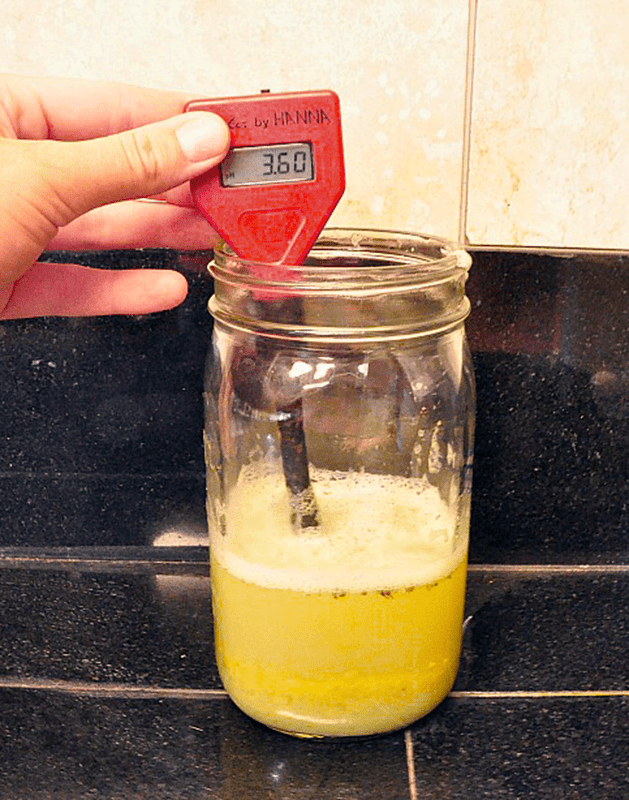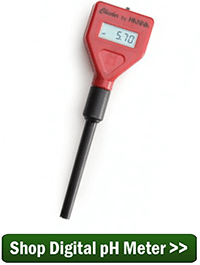 I just had two batches of wine tested for pH levels. One is a Cabernet made from plain juice and its pH is 3.78. The other wine is a Merlot, also made from plain juice and its pH is 4.01. After I drew the samples to be tested I racked both batches of wine and added a quarter tsp. of potassium metabisulfite, both are six gallon batches. Are these in the proper pH range to bottle in a couple more months? If not what do you suggest?
I just had two batches of wine tested for pH levels. One is a Cabernet made from plain juice and its pH is 3.78. The other wine is a Merlot, also made from plain juice and its pH is 4.01. After I drew the samples to be tested I racked both batches of wine and added a quarter tsp. of potassium metabisulfite, both are six gallon batches. Are these in the proper pH range to bottle in a couple more months? If not what do you suggest?
Name: Michael B.
State: PA
—–
Hello Michael,
When we talk about the pH range of wine we have to remember that what we are really talking about is the acidity of the wine. The higher the acidity, the more resistant it will be towards bacterial and mold contamination. Acidity also plays a big role in the flavor profile of the wine. If it didn’t we would just keep adding fruit acids to the wine until it would be completely protected. But the fact is if we did do this the wine would taste extremely sharp or tart.
With that being said, there is a general pH range of wine that we look for – a happy medium, if you will. It’s a range that makes the wine generally safe from spoilage and still great to drink. Depending on the style of wine, a pH range of 3.2 to 3.6 usually fits this bill. Some wines taste better at one end of the range and others at the opposite end, so tasting the wine is recommended as well as pH testing for a final tweaking. In general, white wines have a higher level acidity than red wines. Fruit wines usually have less acidity than either red or white wines.
At a pH of 3.78, your Cabernet is a little out of this range but not by much. I would consider it safe to bottle as-is. For this reason I would go by taste at the point on this particular wine. Remember, the pH scale works backwards, so the wine’s pH of 3.78 is low in acid even though it’s pH reading is a higher number than the 3.6 mentioned before. As you go up in acidity your pH will go down.
Actually taste a sample of the wine and see how it taste. If it taste fine, then do nothing. If it tastes too flat or lifeless, then you need to raise the acid level (lower the pH). This can easily be done with the addition of acid blend. It dissolves instantly into the wine.
How much acid blend to add to any wine to get it into the proper pH range is another question. Since the pH scale is not an even scale, but rather a log or exponential scale, how much you need to add to get from point A to point B depends on what part of the scale you are on. For this reason I recommend taking a sample of the wine and adding measured amounts of acid blend to it until you get it into the proper pH range of wine. If you mess up the sample with too much acid blend, pour it back in with the rest of the batch and start all over. If you get it right, apply the same dosage rate of acid blend to the rest of the batch.
As for your Merlot, the pH of 4.01 is lower in acid than we would like to ward off spoilage. I recommend that you add some acid blend to the wine before bottling, regardless of taste. As before, start with a sample and shoot for a pH reading of 3.7 with your pH strips or digital pH meter. Once you get the entire batch in the proper pH range for the wine, then you can start tasting it and making final adjustments.
Happy Winemaking

Ed…when the questions are tough I typically rely on your inputs…
I have 5 gallons of a rich red, from Frontenac…a cold weather grape…I tasted it and it does have an “attitude” but I bottled it anyway, believing time will tell.
I, however, am considering pulling a few bottles from the batch and testing the acidity…is this the best time to check out then PH (even if bottled, or left in the carboy for a while)?
I made a Niagara wine and the reciepe I used said to add 1/4 tsp of grape tanning per gallon right before you add the yeast. to help to keep it longer shelf life. I did not add it to my wine due to not knowing if it is true and what it would do to the wine. Can you give me any information if this is true or what it may due to my wine?
Thanks
Pat
An excellent explanation. I had just sat down at the computer to get some information about acidity and saw your response.
Talk about timing!
I’ve been making wine for over 30 years, but I always learn something new from your columns.
Thank you.
Pat, tannin will increase the shelf-life and stability of the wine. It does this by lowering the wine’s pH. It also does this by helping proteins to drop out of the wine before bottling. This way they will not drop out over time in the wine bottle.
I have grapes vines in my garden that produce Noble rot every year.
I always gather them then crush them. All I add is sugar, water, and no yeast. Yet always get a fermentation from them. I never check my PH any more since they did not do this Centuries ago. I get a beautifully tasting sweet wine every year after it ferment
Also to my last comment I would like to add that the alcohol content is high like 12 -22 percent. Really high for most wines. I even made one that contained 32% alcohol. Yet it tasted really well.
Unless you fortified the wine, there’s no way you made a 32% wine. No wine yeast will ferment to 32%. Most die off before hitting 18%. Most distillers yeast can only get into the bottom of the 20% range at best.
So whats all this PH talk? I use an acid titration kit to determine acidity. Books I have all speak of acid as a percent ,55 to .90 per unit volume. Most recipes in one text seek a .71 to .75 percent acid to finish
Larry, pH testing is just another way to test the acidity of the wine. pH testing strips are the least expensive and quickest way to check the acid. However, the titration testing is the most accurate form of testing the acid level. Below we have posted a couple of article that will discuss this in more detail.
pH Testing vs. Titration Testing
http://www.eckraus.com/blog/difference-between-ph-and-titratable-acidity-in-wine
http://www.eckraus.com/wine-making-acidity
Good info but what if you think your wine is too acidic? I am fermenting some muscadine wine and persimmon wine that I may try as a cider. I need to bottle this weekend and this batch of muscadine tastes a bit sharper and flatter than last years. Any suggestions to lower acidity.
Court, the most common way to lower the acid level of a wine is to dilute it with water. Below are a couple of articles that will discuss this in more detail and well as provide alternative ways to lower the acid level.
Lowering The Acid
http://www.eckraus.com/blog/lower-the-acidity-of-wine-is-too-tart
http://www.eckraus.com/wine-making-acidity
How to stop fermentation vine?
Ewa, unfortunately, there is really no practical way to successfully stop a fermentation dead in its tracks before it completes. For more information on this subject, please take a look at the article posted below.
How To Stop A Fermentation
http://eckraus.com/wine-making-stop-fermentation/
Do you know of any studies about adjusting pH pre-fermentation versus post. I’ve been making blueberry wine for a few years and have noticed acidcity can be quite higher in berries not fully ripe. My thought is adjust post fermentation.
Also we have been doing a 9-10 day pulp fermentation without fruit bags, punching the cap down 5-6 times a day for color and body before pressing. Do you think this effects pH?
Shouldn’t only tartaric be added at this point in the process as Citric and Malic are not stable acids and can be consumed by whatever LAB may be in the wine or picked up through bottling. Tartaric may drop out as potassium bitartrate but ultimately won’t effect wine quality. I am sure most home winemakers aren’t sterile filtering their wine through an absolute membrane filter. Why risk feeding the microbes if one can avoid it?
Nate, the tartaric acid that drops out at this stage is more significant than the instability the citric and malic acids have. Therefore, tartaric acid is never recommended to be added by itself for adjusting acidity.
I had a very nice Cabernet Sauvignon the other day and held back a little because the acid level was just right.
I Titrated it and it was 6.0. I wrote down the acid level. When I started a Cabernet Sauvignon at home later, I made the acid level also at 6.0. Looking forward to trying the wine after I age foe 1 year or longer. Is the acid lever too high?
started primary fermentation of a grape wine at a temperature of about 61 F then read about it and raised the temp to about 68. is that enough and if so does a day at 61 affect the final product?
Vern, The cooler temperature will not affect the final product. Wine yeast does like to ferment between 70-75 degrees. If you find at 68 degrees the fermentation is a little sluggish, I would try warming it up just a bit more.
Hi Ed
I try my luck every now and so often at making fruit wine. At present I have a batch of strawberries going, BUT is seems after two days of aerobic fermentation as if the process (at 21C) is not getting off the mark. I have only a soil Ph meter and it gives me a reading of 7. Does it have an influence on fermentation activity?